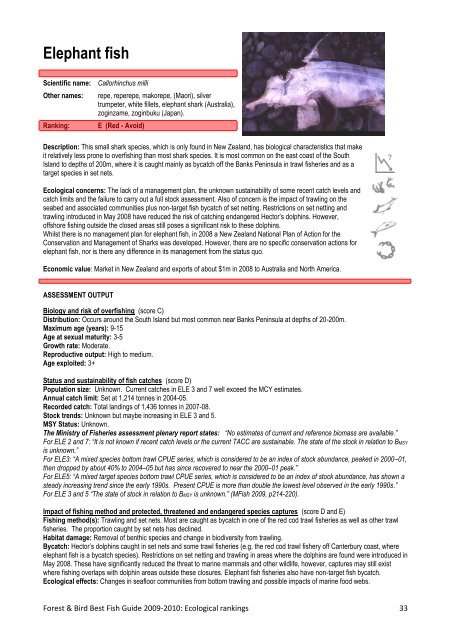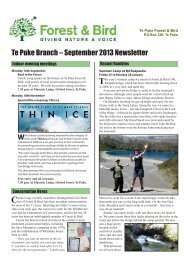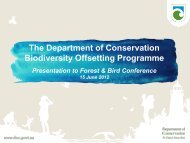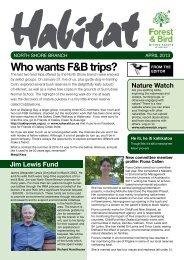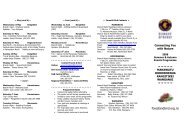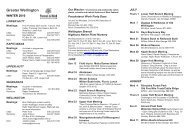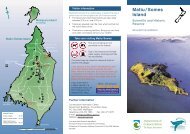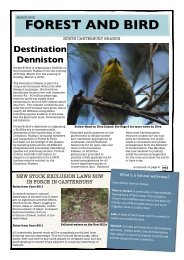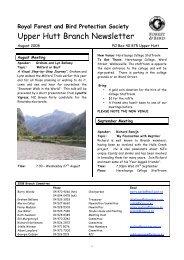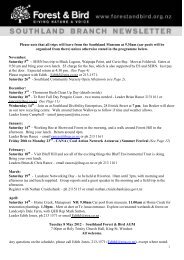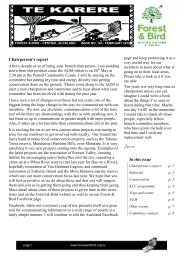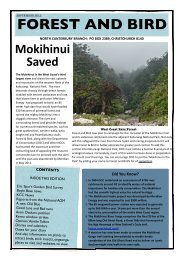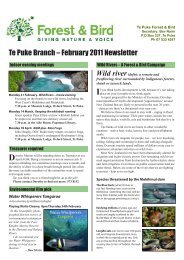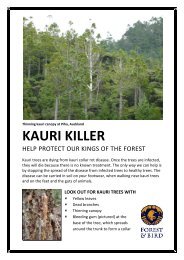Best Fish Guide 2009-2010 - Forest and Bird
Best Fish Guide 2009-2010 - Forest and Bird
Best Fish Guide 2009-2010 - Forest and Bird
You also want an ePaper? Increase the reach of your titles
YUMPU automatically turns print PDFs into web optimized ePapers that Google loves.
Elephant fish<br />
Scientific name: Callorhinchus milli<br />
Other names: repe, reperepe, makorepe, (Maori), silver<br />
trumpeter, white fillets, elephant shark (Australia),<br />
zoginzame, zoginbuku (Japan).<br />
Ranking: E (Red - Avoid)<br />
Description: This small shark species, which is only found in New Zeal<strong>and</strong>, has biological characteristics that make<br />
it relatively less prone to overfishing than most shark species. It is most common on the east coast of the South<br />
Isl<strong>and</strong> to depths of 200m, where it is caught mainly as bycatch off the Banks Peninsula in trawl fisheries <strong>and</strong> as a<br />
target species in set nets.<br />
Ecological concerns: The lack of a management plan, the unknown sustainability of some recent catch levels <strong>and</strong><br />
catch limits <strong>and</strong> the failure to carry out a full stock assessment. Also of concern is the impact of trawling on the<br />
seabed <strong>and</strong> associated communities plus non-target fish bycatch of set netting. Restrictions on set netting <strong>and</strong><br />
trawling introduced in May 2008 have reduced the risk of catching endangered Hector‟s dolphins. However,<br />
offshore fishing outside the closed areas still poses a significant risk to these dolphins.<br />
Whilst there is no management plan for elephant fish, in 2008 a New Zeal<strong>and</strong> National Plan of Action for the<br />
Conservation <strong>and</strong> Management of Sharks was developed. However, there are no specific conservation actions for<br />
elephant fish, nor is there any difference in its management from the status quo.<br />
Economic value: Market in New Zeal<strong>and</strong> <strong>and</strong> exports of about $1m in 2008 to Australia <strong>and</strong> North America.<br />
ASSESSMENT OUTPUT<br />
Biology <strong>and</strong> risk of overfishing (score C)<br />
Distribution: Occurs around the South Isl<strong>and</strong> but most common near Banks Peninsula at depths of 20-200m.<br />
Maximum age (years): 9-15<br />
Age at sexual maturity: 3-5<br />
Growth rate: Moderate.<br />
Reproductive output: High to medium.<br />
Age exploited: 3+<br />
Status <strong>and</strong> sustainability of fish catches (score D)<br />
Population size: Unknown. Current catches in ELE 3 <strong>and</strong> 7 well exceed the MCY estimates.<br />
Annual catch limit: Set at 1,214 tonnes in 2004-05.<br />
Recorded catch: Total l<strong>and</strong>ings of 1,436 tonnes in 2007-08.<br />
Stock trends: Unknown but maybe increasing in ELE 3 <strong>and</strong> 5.<br />
MSY Status: Unknown.<br />
The Ministry of <strong>Fish</strong>eries assessment plenary report states: “No estimates of current <strong>and</strong> reference biomass are available.”<br />
For ELE 2 <strong>and</strong> 7: “It is not known if recent catch levels or the current TACC are sustainable. The state of the stock in relation to BMSY<br />
is unknown.”<br />
For ELE3: “A mixed species bottom trawl CPUE series, which is considered to be an index of stock abundance, peaked in 2000–01,<br />
then dropped by about 40% to 2004–05 but has since recovered to near the 2000–01 peak.”<br />
For ELE5: “A mixed target species bottom trawl CPUE series, which is considered to be an index of stock abundance, has shown a<br />
steady increasing trend since the early 1990s. Present CPUE is more than double the lowest level observed in the early 1990s.”<br />
For ELE 3 <strong>and</strong> 5 “The state of stock in relation to BMSY is unknown.” (M<strong>Fish</strong> <strong>2009</strong>, p214-220).<br />
Impact of fishing method <strong>and</strong> protected, threatened <strong>and</strong> endangered species captures (score D <strong>and</strong> E)<br />
<strong>Fish</strong>ing method(s): Trawling <strong>and</strong> set nets. Most are caught as bycatch in one of the red cod trawl fisheries as well as other trawl<br />
fisheries. The proportion caught by set nets has declined.<br />
Habitat damage: Removal of benthic species <strong>and</strong> change in biodiversity from trawling.<br />
Bycatch: Hector‟s dolphins caught in set nets <strong>and</strong> some trawl fisheries (e.g. the red cod trawl fishery off Canterbury coast, where<br />
elephant fish is a bycatch species). Restrictions on set netting <strong>and</strong> trawling in areas where the dolphins are found were introduced in<br />
May 2008. These have significantly reduced the threat to marine mammals <strong>and</strong> other wildlife, however, captures may still exist<br />
where fishing overlaps with dolphin areas outside these closures. Elephant fish fisheries also have non-target fish bycatch.<br />
Ecological effects: Changes in seafloor communities from bottom trawling <strong>and</strong> possible impacts of marine food webs.<br />
<strong>Forest</strong> & <strong>Bird</strong> <strong>Best</strong> <strong>Fish</strong> <strong>Guide</strong> <strong>2009</strong>-<strong>2010</strong>: Ecological rankings 33<br />
?


